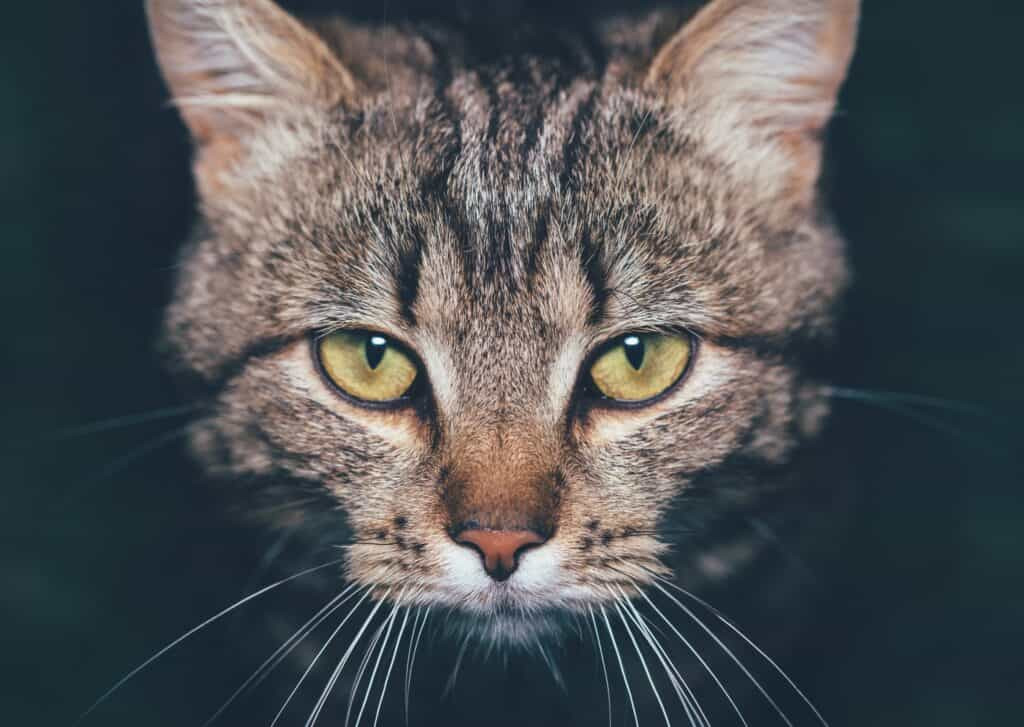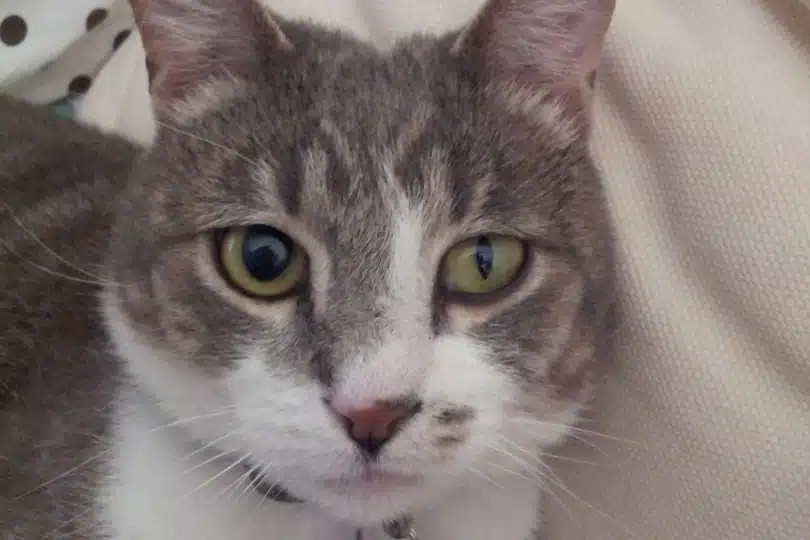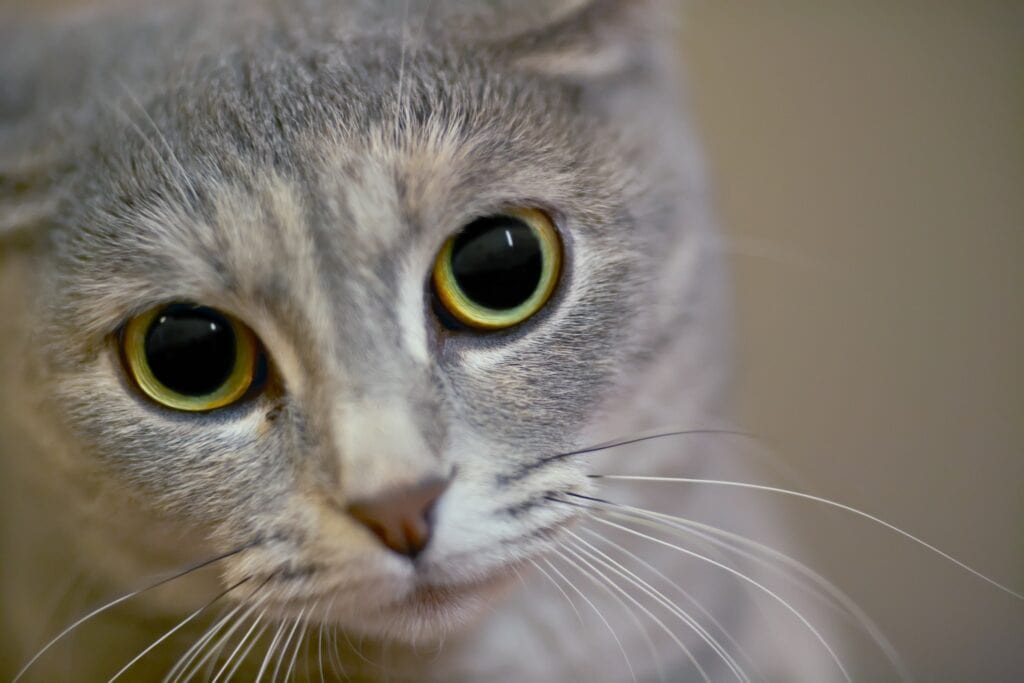Dilated cat eyes, those large, dark pupils that transform your feline friend’s gaze, can be both captivating and concerning. As a cat owner, you’ve likely observed your cat’s pupils changing size, a fascinating adaptation to light and mood. However, when your cat’s eyes are persistently dilated, it’s natural to wonder if it’s simply a quirk of feline physiology or a potential health issue.
Understanding the nuances of dilated cat eyes is essential for responsible pet ownership. While pupil dilation is often a normal physiological response, it can also be a crucial indicator of underlying conditions that require veterinary attention. This comprehensive guide will delve into the common causes of dilated pupils in cats, differentiating between normal variations and situations that warrant a visit to the veterinarian. We’ll explore everything from environmental factors and emotional states to potential medical conditions, empowering you to better understand your cat’s eye health and overall well-being.
Understanding Normal Cat Pupils
To appreciate when dilated cat eyes are a concern, it’s important to first understand what constitutes “normal” for feline pupils. A cat’s pupils are incredibly dynamic, designed to adapt swiftly to varying light conditions and even reflect their emotional state. Typically, in normal lighting, a cat’s pupils appear as vertical slits. This is their baseline, often observed when they are relaxed and content.
However, this slit-like shape is far from static. In bright light, these slits become even narrower, minimizing light intake and protecting their sensitive retinas. Conversely, in dim light, or when a cat is experiencing excitement or heightened alertness, these slits expand into large, round circles, maximizing light entry and enhancing their vision. This rapid adjustment is a testament to their evolutionary adaptation as crepuscular hunters, active during dawn and dusk. Observing these changes in pupil size in response to light changes is a normal and healthy function of your cat’s eyes.
 dilated cat eyes
dilated cat eyes
Common Reasons for Dilated Cat Eyes: Beyond Medical Concerns
While dilated cat eyes can sometimes signal health problems, it’s crucial to recognize the many non-medical reasons why your cat’s pupils might be large. Often, these are perfectly normal and simply reflect your cat’s environment or emotional state.
Low Light Conditions: The most frequent and benign cause of dilated pupils is simply darkness. Just like our own eyes, a cat’s pupils dilate in low-light environments to gather as much light as possible. This adaptation significantly enhances their night vision, allowing them to navigate and hunt effectively even when it’s dimly lit. If you notice your cat’s pupils are large in a dimly lit room, it’s likely just their eyes working as they should to improve their sight.
Excitement and Playfulness: Observe your cat during playtime, especially when they are engaged in hunting simulations with toys. You’ll likely notice their pupils become large and round. This dilation is a physiological response to excitement and heightened arousal. The surge of adrenaline associated with play triggers pupil dilation, enhancing their focus and alertness as they “hunt” and “pounce.”
Fear or Anxiety: Similar to excitement, fear and anxiety can also cause dilated pupils. This is part of the “fight-or-flight” response, a survival mechanism that prepares them to react to perceived threats. Dilated pupils in fearful situations allow cats to take in a wider field of vision, increasing their awareness of potential dangers in their surroundings. If your cat is in a new environment, startled by a loud noise, or exhibiting other signs of stress, dilated pupils might simply be a manifestation of their anxiety.
Pain or Discomfort: Dilated pupils can also be a subtle indicator of pain. When a cat is experiencing pain, their body releases adrenaline, which can lead to pupil dilation. If you observe dilated pupils accompanied by other signs of discomfort, such as hiding, decreased appetite, changes in vocalization (excessive meowing or hissing), or reluctance to be touched, it’s important to consider pain as a possible cause and consult with your veterinarian.
TikTok user @echothebengal demonstrates how his pupils dilate before attacking a family member.Medical Conditions Associated with Persistently Dilated Pupils in Cats
When dilated pupils become persistent, especially in normal or bright light conditions, it can be a red flag for several underlying medical conditions. It’s crucial to be aware of these potential health issues and seek veterinary advice if you notice persistent dilation.
Hypertension (High Blood Pressure): Feline hypertension, or high blood pressure, can have a significant impact on eye health and can cause dilated pupils. High blood pressure can damage blood vessels in the retina, leading to retinal detachment and subsequent vision changes, which in turn can cause pupils to dilate. Hypertension in cats is often secondary to other conditions, such as chronic kidney disease or hyperthyroidism, particularly in older cats. Other symptoms of hypertension can include weight loss, changes in appetite, and poor coat quality.
Eye Disorders: Glaucoma and Uveitis: Certain eye disorders directly impact pupil function. Glaucoma, characterized by increased pressure inside the eye, can directly cause pupil dilation. This increased pressure can damage the optic nerve and lead to blindness if left untreated. Uveitis, inflammation of the middle layer of the eye (uvea), can also cause dilated pupils, along with other symptoms like eye redness, pain, and increased tear production.
Progressive Retinal Atrophy (PRA): PRA is a degenerative eye disease where the cells of the retina gradually deteriorate. As the retina loses function, the cat’s vision diminishes, and the pupils may dilate in an attempt to compensate for reduced light sensitivity. PRA is often hereditary and can eventually lead to blindness.
Iris Atrophy: Iris atrophy is a degenerative condition where the iris, the colored part of the eye responsible for pupil control, thins and deteriorates. This thinning can impair the iris’s ability to constrict the pupil properly, leading to persistent dilation. Iris atrophy is more common in older cats and may affect one or both eyes.
Ocular and Brain Tumors: Tumors affecting the eye structures or the brain can also disrupt normal pupil function. Tumors in the eye can directly interfere with the nerves and muscles controlling the pupil. Brain tumors, depending on their location, can also affect the neurological pathways that regulate pupil size. Other signs associated with tumors may include chronic pain, third eyelid protrusion, eye discharge, and cloudy eyes.
Anisocoria (Uneven Pupils): Anisocoria refers to a condition where the pupils are unequal in size, with one pupil being more dilated than the other. This is a significant sign that often indicates a neurological or ocular issue. Anisocoria can be caused by corneal ulcers, Horner’s syndrome (a neurological disorder), or head trauma. It always warrants prompt veterinary attention.
Poor Vision: As a cat’s vision deteriorates due to age or underlying conditions, their pupils may dilate in a compensatory effort to gather more light. Cats with poor vision might also exhibit other signs, such as squinting, bumping into objects, or appearing hesitant in unfamiliar environments.
Feline Dysautonomia (Key-Gaskell Syndrome): Feline dysautonomia is a rare but serious neurological condition affecting the autonomic nervous system. This system controls involuntary functions, including pupil size, digestion, and breathing. Dysautonomia can cause widespread symptoms, including dilated pupils that are unresponsive to light, along with respiratory difficulties and gastrointestinal upset.
 anisocoria
anisocoria
Image Credit: Example of anisocoria in a cat (Blumoon531, via Wikimedia Commons, CC BY-SA 4.0)
When Should Dilated Cat Eyes Prompt a Veterinary Visit?
While it’s reassuring to know that dilated pupils are often normal, it’s crucial to recognize when they become a cause for concern. Here are key situations where dilated cat eyes warrant a prompt veterinary examination:
-
Persistent Dilation: If you notice your cat’s pupils remaining dilated for an extended period, especially in bright light conditions where they should normally constrict, this is a strong indication of a potential problem. Normal pupils should react to changes in light within seconds. If dilation persists for hours, it’s time to consult a vet.
-
Accompanying Symptoms: Pay close attention to whether dilated pupils are accompanied by other symptoms. Lethargy, vomiting, loss of appetite, changes in behavior (such as increased hiding or aggression), or any signs of pain (whining, limping, reluctance to be touched) alongside dilated pupils are all reasons to seek veterinary care.
-
Eye Abnormalities: Any other abnormalities in the eyes, in addition to dilation, are concerning. Cloudiness within the eye, discharge (especially if colored or excessive), redness of the whites of the eyes (sclera), or any swelling around the eyes should be evaluated by a veterinarian immediately.
-
Sudden Vision Changes: If you suspect your cat is experiencing vision loss, indicated by dilated pupils and behaviors like bumping into furniture, becoming easily startled, or hesitant to jump, a veterinary visit is essential.
-
Age and Pre-existing Conditions: Senior cats and cats with pre-existing health conditions are more susceptible to issues that can manifest as dilated pupils. Regular veterinary check-ups are particularly important for these cats, and any changes, including dilated pupils, should be discussed with your vet.
What to Expect During a Veterinary Examination for Dilated Cat Eyes
When you bring your cat to the vet for dilated pupils, the veterinarian will conduct a thorough examination to determine the underlying cause. This typically involves:
- Comprehensive Physical Examination: A general health check, including listening to the heart and lungs, palpating the abdomen, and checking vital signs.
- Ophthalmic Examination: A detailed examination of the eyes. This will include:
- Pupillary Light Reflex Test: Assessing how the pupils respond to light.
- Ophthalmoscopy: Using an ophthalmoscope to examine the internal structures of the eye, including the retina, optic nerve, and blood vessels. This helps to identify conditions like PRA or retinal detachment.
- Tonometry: Measuring the intraocular pressure (pressure inside the eye) to screen for glaucoma.
- Baseline Bloodwork and Urinalysis: These tests assess overall organ function and can help identify systemic conditions like kidney disease, diabetes, or hyperthyroidism that can contribute to hypertension and eye problems.
- Blood Pressure Measurement: To check for hypertension, especially in older cats or those with suspected kidney or thyroid issues.
- Advanced Diagnostics (If Necessary): In some cases, further diagnostics may be required, such as:
- Ocular Ultrasound: To visualize the internal structures of the eye in more detail, particularly if there is cloudiness preventing a clear view with ophthalmoscopy.
- CT Scan or MRI: If a brain tumor is suspected as the cause of dilated pupils, advanced imaging like CT scans or MRIs may be recommended.
Dilated Pupils and Vision Loss in Cats
A significant consequence of several conditions that cause dilated pupils is vision loss. When a cat starts to lose its vision, their pupils often dilate as a natural attempt to maximize light intake and improve visibility. If you observe persistently dilated pupils alongside any of the following signs, your cat may be experiencing vision loss:
Signs of Vision Loss in Cats:
- Hesitation or reluctance to jump onto familiar surfaces or climb stairs.
- Squinting or excessive blinking.
- Redness or inflammation around the eyes.
- Eyes appearing milky or cloudy.
- Displaying unsteadiness or clumsiness while walking.
- Difficulty locating food or water bowls.
- Walking with whiskers held close to the ground (using them as sensory aids).
- Being easily startled by sudden noises or movements.
- Increased vocalization, often meowing loudly or seeming distressed.
Simple Ways to Check Your Cat’s Vision at Home
You can perform some simple, non-invasive tests at home to get a preliminary sense of your cat’s vision. If you observe any abnormalities during these tests, it’s crucial to schedule a veterinary exam.
- Laser Pointer Test: Swiftly move a laser pointer dot across the floor in front of your cat. A cat with normal vision will typically track the light with their eyes and may attempt to pounce or chase it.
- Cotton Ball Test: Toss a cotton ball lightly in front of your cat’s path, ensuring it falls within their field of vision. Cats usually notice and react to the soft, floating cotton ball. A cat with vision impairment may not notice it.
- Hand Wave Test: Gently wave your hand quickly towards your cat’s eyes (without creating a breeze or touching them). A cat with normal vision should blink or react defensively to the approaching movement.
- Light Reflex Test: Briefly shine a small, focused light (like a penlight) into your cat’s eyes in a dimly lit room. Observe if the pupils constrict (become smaller) in response to the light.
Caring for a Cat with Vision Loss
If your cat is diagnosed with permanent vision loss, there are many ways you can adapt your home and routine to ensure they live a happy and fulfilling life. Cats are remarkably adaptable, and blind cats can thrive with a few adjustments.
- Maintain a Consistent Environment: Keep furniture and food/water bowls in the same locations. Avoid rearranging furniture, as this can disorient a blind cat.
- Verbal Communication: Talk to your cat frequently in a calm and reassuring voice. This helps them orient themselves and feel secure.
- Announce Your Presence: Always announce your presence before approaching or touching your cat, to avoid startling them.
- Ensure Safe Pathways: Keep hallways and walkways clear of obstacles. Remove any tripping hazards.
- Minimize Loud Noises: Sudden loud noises can be particularly distressing for blind cats, as they rely more heavily on their hearing. Try to minimize loud or startling sounds in their environment.
 grey cat with dilated cat eyes
grey cat with dilated cat eyes
Final Thoughts: Being Attentive to Your Cat’s Eye Health
Dilated cat eyes are a fascinating aspect of feline physiology, often reflecting normal responses to light, emotion, and play. However, it’s essential to be a vigilant cat owner and recognize when dilated pupils might indicate a more serious underlying health issue. Persistent dilation, especially when accompanied by other symptoms or eye abnormalities, should never be ignored.
By understanding the common causes of dilated pupils and knowing when to seek veterinary care, you can play a crucial role in safeguarding your feline companion’s health and well-being. Regular observation, coupled with prompt veterinary attention when needed, ensures that you are providing the best possible care for your beloved cat and addressing any potential health concerns proactively. When in doubt about your cat’s eye health, always err on the side of caution and consult with your veterinarian.

